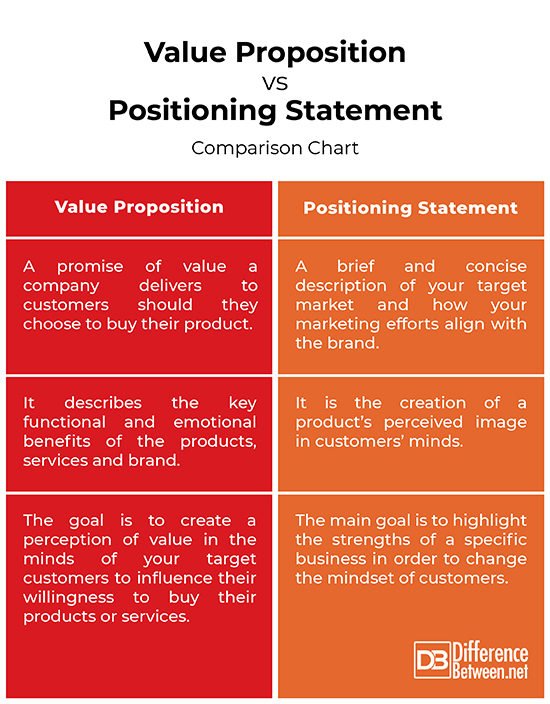Difference Between Value Proposition and Positioning Statement
The terms value proposition and positioning statement are often used interchangeably, but they are not the same. Each one is important and related, but they serve very different functions. Both are part of marketing strategies designed to differentiate companies from their competitors. We look at some key differences between the two to help you better understand their significance.

Value Proposition
Value proposition is a simple statement, a promise of value a company delivers to customers should they choose to buy their product. The term ‘value proposition’ is used ubiquitously in business today and is often used to mean benefits, offering, unique selling point (USP), or differentiation. It is generally regarded as the preserve of sales and marketing and is not linked to an organization’s strategy. It is a direct output of an organization’s business strategy. It states your brand promise along with the benefits offered to multiple market segments and what customers pay for those benefits.
An effective value proposition says a lot; it says customers why they should buy from you and not your competition. It describes the key functional and emotional benefits of the products, services and brand. It is the essential articulation of the values at any organization where the business or non-profit provides to its customers. Simply put, it describes the collection of products and services a business offers to meet the needs of its customers.

Positioning Statement
Positioning statement is basically a subset of value proposition used in marketing communication programs and activities. It is a brief and concise description of your target market and how your marketing efforts align with the brand. Your positioning impacts almost all aspects of your branding and how your market sees you. If a company wants to be truly customer-oriented, it needs to choose a marketing strategy. The company will then choose a target group and position itself in the market.
Positioning is the creation of a product’s perceived image in customers’ minds. It is the ultimate step in differentiating between existing and would-be customers. It is like a statement that tells a target group why the product is unique from other similar products in the market and how it fulfills the customers’ needs. The goal of a positioning statement is to align your marketing efforts with your brand and value proposition. It simply is a one-liner that says what you do, who you do it for, and the benefits they receive when they work with you.
Difference between Value Proposition and Positioning Statement
Definition
– Value proposition is a direct output of a company’s business strategy that reflects a promise of value that company delivers to customers should they choose to buy their products or services. It could be a product, service, or feature intended to make a company attractive to customers. Positioning statement, on the other hand, is an expression of how a given product or service fulfills its customers’ needs in a way that its competitors don’t. Positioning is the creation of a product’s perceived image in customers’ minds.
Goal
– Value proposition is the essential articulation of the values at any organization where the business or non-profit provides to its customers. The goal is to create a perception of value in the minds of your target customers to in order to influence their willingness to buy their products or services. Positioning statement gives a concrete form of communication to better explain your positioning and value proposition. It is about communicating how your brand is different or unique from other similar competing brands. The main goal is to highlight the strengths of a specific business.
Value Proposition vs. Positioning Statement: Comparison Chart

Summary
Both value proposition and positioning statement are part of business marketing strategy. Positioning is the creation of a product’s perceived image in customers’ minds. Positioning is the ultimate step in differentiating between existing and would be competitors. A concept strongly linked to positioning is proposition, also referred to as value proposition. Value proposition is the promise to the customer. It is the translation of the positioning into a concrete promise. Positioning is about communicating how your brand is different or unique from other similar competing brands.
What is a positioning statement?
Positioning is the articulation of your value proposition that makes your brand or product unique or different from your competitors’.
Is positioning statement same as USP?
Positioning statement and USP are essentially the same thing. USP is typically what you think your strengths are, whereas positioning is what your target customers perceive of you.
What are 4 elements of a positioning statement?
The four basic elements of a positioning statement are target audience, frame of reference (FOR), point of difference (POD), and reason to believe.
What is the difference between a value proposition and a mission statement?
A value proposition is a promise of value that summarizes why a customer would choose your product or service. A mission statement describes the purpose of a company in simple and concise terms.
- Difference Between Caucus and Primary - June 18, 2024
- Difference Between PPO and POS - May 30, 2024
- Difference Between RFID and NFC - May 28, 2024
Search DifferenceBetween.net :
Leave a Response
References :
[0]Osterwalder, Alexander, et al. Value Proposition Design: How to Create Products and Services Customers Want. New Jersey, United States: John Wiley & Sons, 2015. Print
[1]Barnes, Cindy, et al. Creating and Delivering Your Value Proposition: Managing Customer Experience for Profit. London, United Kingdom: Kogan Page, 2009. Print
[2]Kostelijk, Erik and Karel Jan Alsem. Brand Positioning: Connecting Marketing Strategy and Communications. England, UK: Routledge, 2020. Print
[3]Viardot, Eric. Successful Marketing Strategy for High-tech Firms. Massachusetts, United States: Artech House, 2004. Print
